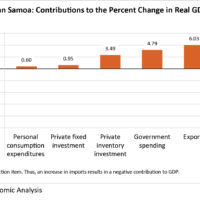
Real gross domestic product (GDP) for American Samoa increased 4.0 percent in 2020 after decreasing 0.6 percent in 2019, according to statistics released today by the U.S. Bureau of Economic Analysis (BEA).
These statistics were developed under the Statistical Improvement Program funded by the Office of Insular Affairs (OIA) of the U.S. Department of the Interior.
The increase in real GDP reflected widespread growth among the major components of GDP including exports, private inventory investment, and government spending. These increases were partly offset by an increase in imports, which is a subtraction item in the calculation of GDP.
Activity related to the tuna canning industry was a significant source of growth in the American Samoa economy. The canning industry’s operations in American Samoa were less affected by the COVID-19 pandemic in comparison to other parts of the world.
Exports of goods increased 15.5 percent, reflecting an increase in exports of canned tuna and related products. Private inventory investment increased, reflecting growth in supplies held by the tuna canning industry.
Government spending increased 10.1 percent; the increase was accounted for by growth in territorial government spending. Spending by the American Samoa government was supported by federal grant revenues, including Coronavirus Relief Fund payments.
In 2019, GDP declined by 0.6 percent. The newly available GDP by industry data, which are released on a 1-year lag, reveal that the 2019 GDP decline was the result of a decline in the private sector that was partly offset by an increase in the public sector.
The contraction in the private sector reflected declines in both manufacturing and nonmanufacturing. Manufacturing value added decreased 4.7 percent, reflecting decreased cannery output. Nonmanufacturing value added decreased 1.0 percent, largely reflecting decreases in industries that had previously supported reconstruction activities associated with Tropical Cyclone Gita.
The government sector increased 2.1 percent, primarily reflecting increases in compensation of territorial government employees and operating surplus of territorial government enterprises.
Total compensation increased in 2019, reflecting growth in manufacturing industries and in the territorial government sector.




